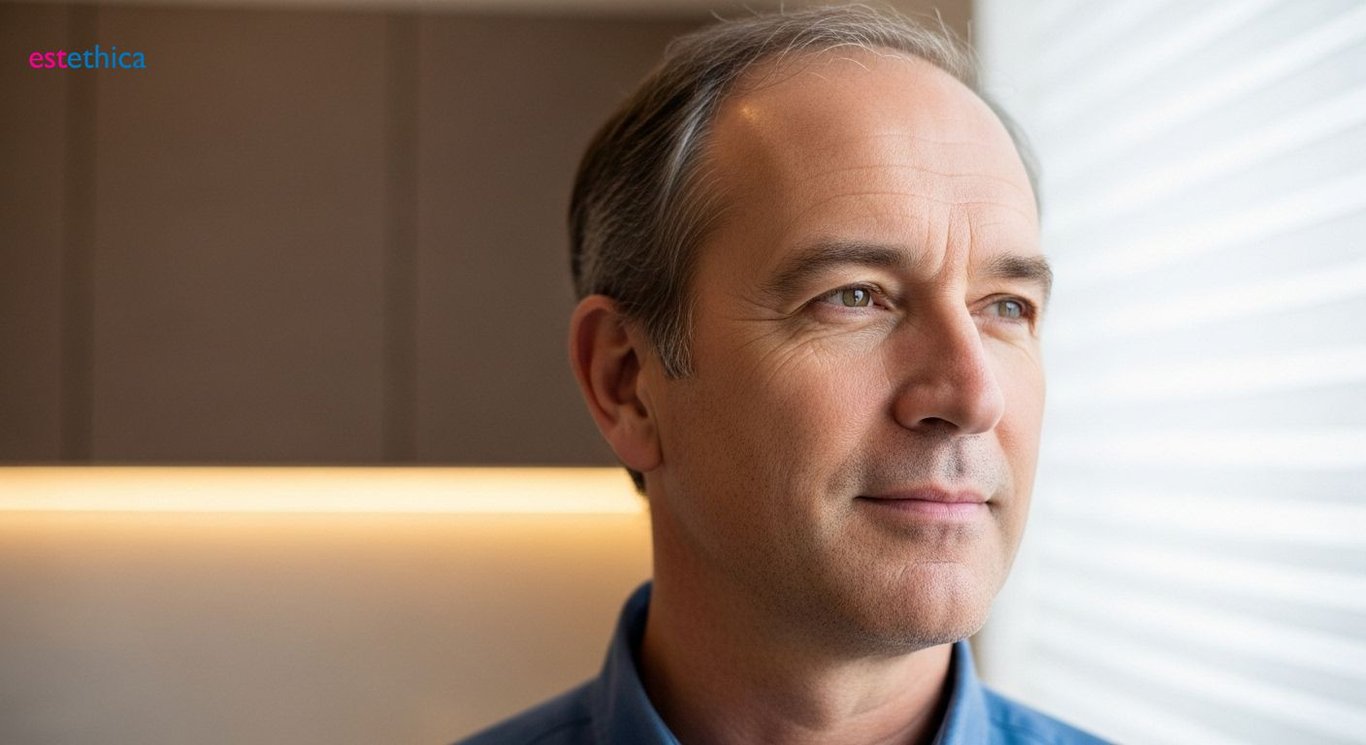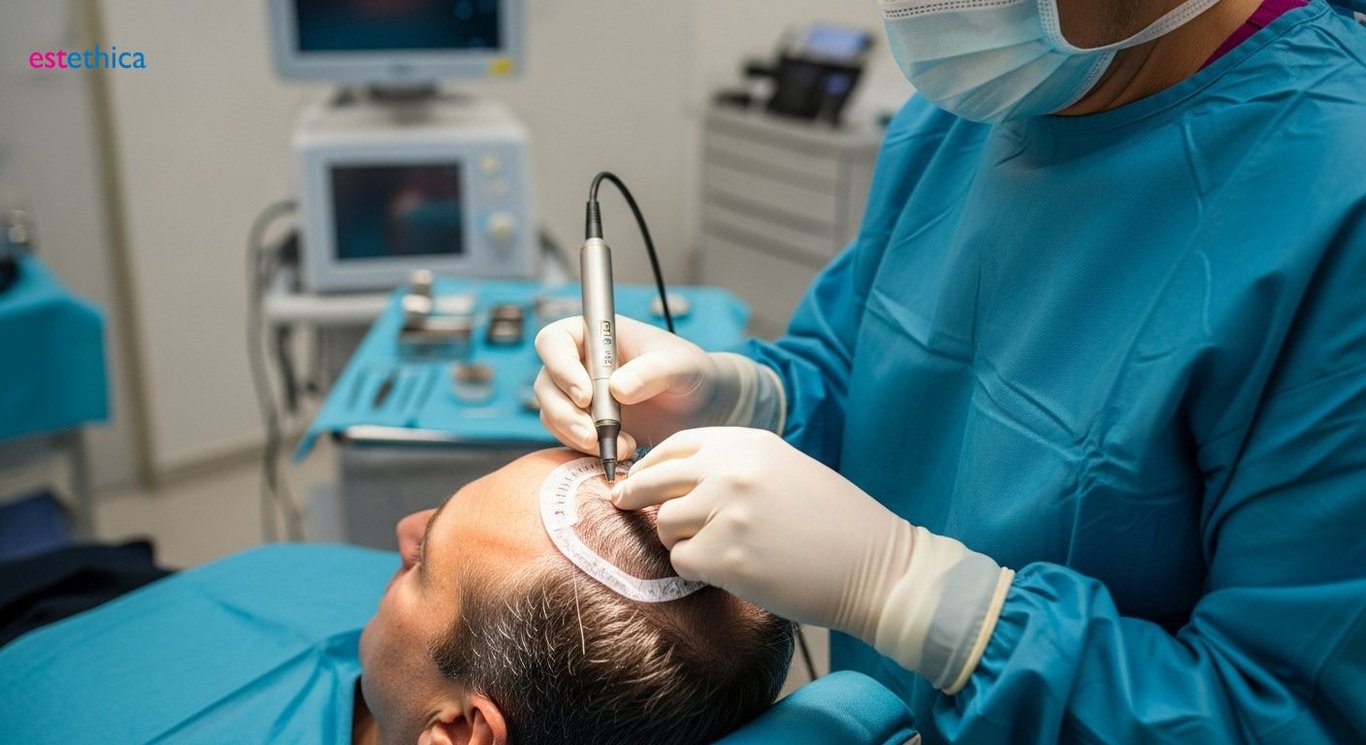Hair Restoration Revolution: Techniques & Choosing Your Surgeon
Discover how to unlock your hair's potential with advanced hair restoration techniques and expert guidance from estethica.
Welcome to Your Ultimate Destination for Hair Restoration: Understanding the Modern Approaches
If you're struggling with hair loss, know that you're not alone and there are numerous effective solutions available today. Hair transplantation has transformed over the years with cutting-edge technologies, offering options to not just cover bald spots, but provide a natural and lasting solution. In this guide, we'll navigate through the various aspects of hair restoration, focusing on the techniques, procedures, and aftercare, specifically tailored for you.
Decoding Hair Loss: Understanding Male Pattern Baldness and Beyond
Understanding the Roots of Male Pattern Baldness
Male pattern baldness, also known as androgenetic alopecia, impacts a significant portion of the male population. The condition is largely influenced by genetics and hormonal factors, particularly sensitivity to dihydrotestosterone (DHT). DHT, a derivative of testosterone, shrinks hair follicles over time, leading to thinner and shorter hair strands. This process eventually results in complete cessation of hair growth in affected areas. Understanding these factors is crucial for exploring effective hair loss treatment options.
- Genetic Predisposition: A family history of baldness significantly increases the likelihood of developing male pattern baldness. Specific genes influence the sensitivity of hair follicles to DHT.
- Hormonal Influence: DHT binds to receptors in hair follicles, causing them to miniaturize. This process shortens the growth phase of hair, leading to finer and less visible hair.
- Age Factor: The prevalence of male pattern baldness increases with age. While it can begin as early as the late teens, it becomes more noticeable in the 30s and beyond.
The progression of male pattern baldness typically follows a predictable pattern, starting with a receding hairline and thinning at the crown. Early intervention can help slow down or even reverse some of the effects of DHT on hair follicles. For instance, a 2024 study indicated that early intervention with treatments can preserve up to 30% more hair density over five years compared to delayed treatment. Recognizing the early signs and understanding the underlying causes are the first steps toward effective management and potential hair restoration.
Navigating Hair Loss: A Guide to Stages and Solutions
The Norwood Scale is a widely used classification system that outlines the stages of male pattern baldness. This scale helps individuals identify the extent of their hair loss and determine appropriate treatment strategies. The stages range from minimal recession at the hairline to extensive baldness across the scalp. Recognizing these stages is essential for making informed decisions about hair transplant or other hair loss treatment options.
- Stage 1: Minimal or no hair loss. The hairline shows little to no recession, and there is no significant thinning at the crown.
- Stage 3 Vertex: Noticeable thinning at the crown (vertex) of the head. The hairline may also show some recession.
- Stage 5: Significant hair loss. The receding hairline and thinning crown merge, leaving only a narrow band of hair at the sides and back of the head.
Understanding these stages allows individuals to seek timely intervention. For example, someone in Stage 3 might consider medical treatments to slow down hair loss, while someone in Stage 5 might explore hair transplant options. The Norwood Scale provides a framework for discussing hair loss with professionals and developing a personalized treatment plan. Consulting with a hair transplant clinic can provide tailored advice and explore options such as follicular unit extraction (FUE) or follicular unit transplantation (FUT) to address male pattern baldness effectively.

FUE vs. FUT: Choosing the Best Hair Transplant Technique for You
Understanding FUE and FUT Techniques for Hair Restoration
Deciding between Follicular Unit Extraction (FUE) and Follicular Unit Transplantation (FUT) is a pivotal choice for individuals seeking hair restoration. FUE involves the extraction of individual hair follicles directly from the scalp, known for leaving minimal scarring and enabling a quicker recovery period. FUT, alternatively, involves removing a strip of scalp from which hair follicles are then extracted. FUT is often favored for covering extensive areas of hair loss, making it a viable option for those with advanced male pattern baldness. Understanding the distinct advantages and disadvantages of each method is essential for making a well-informed decision that aligns with your specific needs and expectations.
- FUE (Follicular Unit Extraction): Involves extracting individual hair follicles, resulting in minimal scarring and faster recovery.
- FUT (Follicular Unit Transplantation): Involves removing a strip of scalp, suitable for covering larger bald areas.
- Scarring: FUE leaves tiny, virtually undetectable scars, while FUT results in a linear scar.
Factors Influencing the Choice Between FUE and FUT
The choice between FUE and FUT is influenced by several factors, including the extent of hair loss, the patient’s lifestyle, and specific aesthetic goals. FUE is often preferred by those who desire the flexibility of shorter hairstyles post-procedure, as the scarring is less noticeable. FUT, on the other hand, might be more suitable for individuals needing a large number of grafts to cover significant baldness. The density of the donor area also plays a crucial role; individuals with high donor density might be better candidates for FUT, while those with lower density might benefit more from FUE. Consulting with a hair transplant clinic is essential to assess these factors and determine the most appropriate technique.
- Extent of Hair Loss: FUT is often more efficient for covering larger bald areas in a single session.
- Lifestyle: FUE is suitable for those who prefer shorter hairstyles due to minimal scarring.
- Donor Area Density: High donor density favors FUT, while lower density may benefit more from FUE.

Finding the Right Hands: How to Choose a Hair Transplant Surgeon
Evaluating Surgeon Credentials and Experience
Selecting a surgeon with the right credentials and extensive experience is crucial for a successful hair transplant. Look for board certifications in relevant specialties such as dermatology or plastic surgery, which indicate a high level of training and expertise. Experience is equally important; a surgeon who has performed numerous hair restoration procedures is more likely to deliver consistent and satisfactory results. Verify the surgeon's credentials through professional organizations and medical boards to ensure they are in good standing.
- Board Certification: Ensures the surgeon has met rigorous standards of training and knowledge in their specialty.
- Years of Experience: Indicates the surgeon has likely encountered and successfully managed a variety of cases.
- Professional Standing: Verifies the surgeon has no disciplinary actions or malpractice claims.
Consider surgeons who specialize specifically in hair transplant procedures, as their focused expertise can lead to better outcomes. For instance, a surgeon who dedicates their practice to hair restoration is likely more proficient in the latest techniques, such as follicular unit extraction (FUE) and follicular unit transplantation (FUT). A recent survey showed that patients who chose surgeons with over ten years of experience reported a 25% higher satisfaction rate. Checking the surgeon's background and experience is a critical step in ensuring a successful hair transplant journey.
Assessing Clinic Reputation and Patient Reviews
The reputation of the hair transplant clinic and feedback from past patients are invaluable resources when choosing a surgeon. Look for clinics with a strong track record of positive outcomes and high patient satisfaction. Online reviews and testimonials can provide insights into the experiences of others, highlighting both the strengths and weaknesses of the clinic and its surgeons. Pay attention to comments regarding the surgeon's bedside manner, the clarity of pre- and post-operative instructions, and the overall quality of care.
- Online Reviews: Provide direct feedback from previous patients about their experiences.
- Before-and-After Photos: Offer visual evidence of the surgeon's skill and the clinic's results.
- Consultation Experience: Assesses the surgeon's communication skills and their ability to address your concerns.
A reputable clinic will also be transparent about their procedures, providing detailed information about the techniques used, the expected recovery time, and potential risks. For example, a clinic that openly discusses the pros and cons of both FUE hair transplant and FUT hair transplant demonstrates a commitment to informed consent. Be wary of clinics that make unrealistic promises or pressure you into making a quick decision. The best hair restoration outcomes often come from clinics that prioritize patient education and personalized care. Checking patient reviews and assessing the clinic's reputation are essential steps in finding the right hands for your hair loss treatment.

Beyond the Procedure: Hair Transplant Recovery Time and Aftercare Essentials
Immediate Post-Op Care: The First 48 Hours
The initial 48 hours following a hair transplant are critical for ensuring the survival of newly implanted grafts. During this period, it's essential to adhere strictly to the post-operative instructions provided by your hair transplant clinic. This typically includes avoiding strenuous activities, keeping the scalp clean and dry, and taking prescribed medications to prevent infection and reduce swelling. Proper care during this phase significantly impacts the overall success of the hair restoration.
- Gentle Cleansing: Use a mild shampoo as directed to keep the scalp clean and prevent infection.
- Medication Adherence: Take all prescribed antibiotics and anti-inflammatory medications to minimize complications.
- Sleep Position: Elevate your head while sleeping to reduce swelling and protect the newly transplanted grafts.
One common concern during this period is swelling around the forehead and eyes. Applying cold compresses can help minimize this effect. It's also crucial to avoid touching or scratching the recipient area to prevent dislodging the grafts. For example, patients are often advised to wear a loose-fitting hat when outdoors to protect the scalp from direct sunlight and potential trauma. Adhering to these guidelines in the immediate aftermath of the procedure can significantly enhance the long-term results of your hair transplant and ensure a smooth recovery process. Remember, proper aftercare is as vital as the surgery itself for achieving optimal outcomes in hair loss treatment.
Long-Term Maintenance: Nurturing Your New Hair
Long-term maintenance is essential for preserving the results of your hair transplant and ensuring the continued health of your transplanted hair. This involves adopting a consistent hair care routine, protecting your scalp from sun exposure, and maintaining a healthy lifestyle to promote optimal hair growth. Regular follow-up appointments with your hair restoration surgeon can also help monitor the progress of your transplanted hair and address any concerns that may arise.
- Scalp Protection: Shield your scalp from excessive sun exposure by wearing a hat or using sunscreen.
- Healthy Diet: Consume a balanced diet rich in vitamins and minerals to support hair growth and overall health.
- Gentle Hair Care: Use gentle, sulfate-free shampoos and conditioners to avoid damaging the transplanted hair.
For instance, incorporating foods rich in biotin, zinc, and iron can contribute to stronger and healthier hair. Additionally, avoiding harsh chemicals and heat styling can prevent damage to the transplanted follicles. Patients might also consider low-level laser therapy (LLLT) to stimulate hair growth and improve hair density. Maintaining realistic expectations and understanding that the transplanted hair will continue to age naturally is also important. By adopting these long-term maintenance strategies, individuals can maximize the longevity and appearance of their hair transplant results. Remember, ongoing care is a vital component of successful hair loss treatment.
Advanced FUE and FUT Techniques for Natural Hair Restoration
estethica employs both Follicular Unit Extraction (FUE) and Follicular Unit Transplantation (FUT) techniques, offering tailored solutions for hair restoration. FUE ensures minimal scarring and quicker recovery by extracting individual hair follicles, while FUT is ideal for covering extensive areas of hair loss.
estethica's surgeons hold board certifications in dermatology and plastic surgery, ensuring a high standard of training and expertise in hair restoration procedures. Specialization in hair transplant procedures, including proficiency in FUE and FUT techniques, leads to consistent and satisfactory patient outcomes.
Meticulous Post-Operative Care Ensuring Graft Survival and Optimal Results
estethica emphasizes strict adherence to post-operative instructions, including gentle cleansing, medication adherence, and proper sleep positioning, to ensure the survival of newly implanted grafts. Long-term maintenance strategies, such as scalp protection, a healthy diet, and gentle hair care, are essential for preserving the results of hair transplant procedures.
estethica prioritizes patient education and personalized care, providing detailed information about procedures, expected recovery times, and potential risks. Transparency in discussing the pros and cons of both FUE and FUT hair transplant techniques demonstrates a commitment to informed consent and realistic patient expectations.
Frequently Asked Questions
What is a hair transplant and how does it work?
What are the main techniques used in hair restoration?
How do I choose the right hair transplant clinic and surgeon?
What is the recovery process like after a hair transplant?
How long do hair transplant results last?
Achieve your aesthetic goals with estethica's expert guidance and advanced techniques.
📞 Call Now for a Free Consultation!